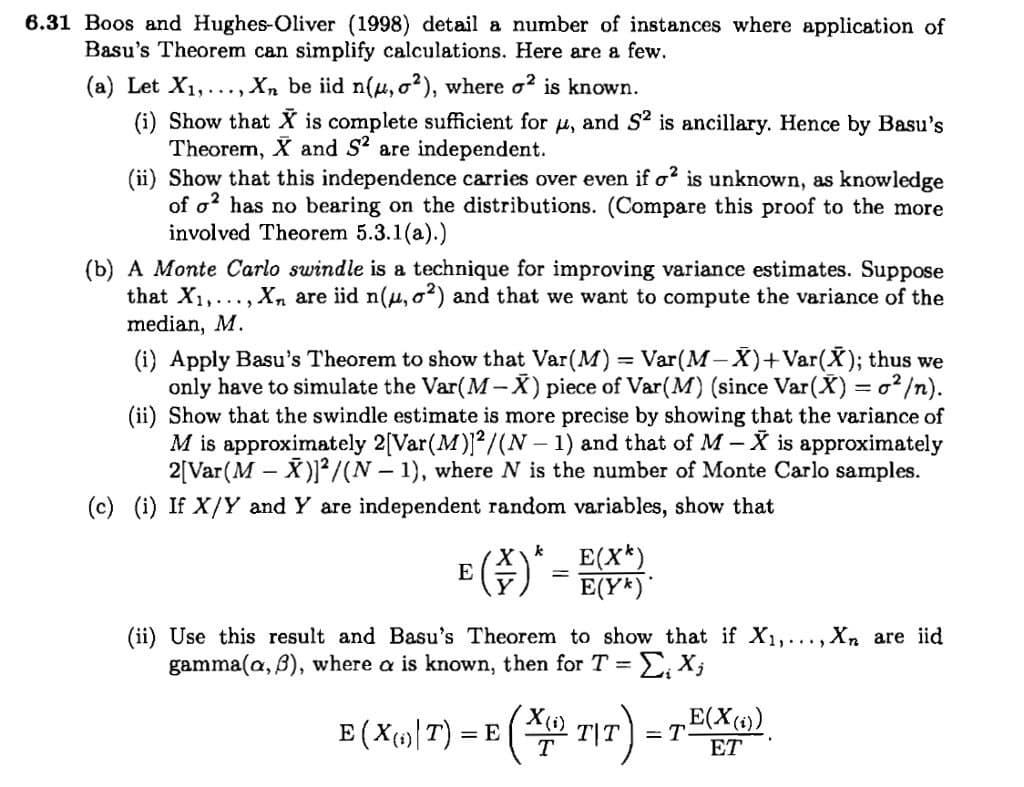6.31 Boos and Hughes-Oliver (1998) detail a number of instances where application of Basu's Theorem can simplify calculations. Here are a few. (a) Let X1,..., Xn be iid n(µ, o²), where o² is known. (i) Show that X is complete sufficient for , and S2 is ancillary. Hence by Basu's Theorem, X and S? are independent. (ii) Show that this independence carries over even if o is unknown, as knowledge of o? has no bearing on the distributions. (Compare this proof to the more involved Theorem 5.3.1(a).) (b) A Monte Carlo swindle is a technique for improving variance estimates. Suppose that X1,..., X, are iid n(u, o²) and that we want to compute the variance of the median, M. (i) Apply Basu's Theorem to show that Var(M) = Var(M-X)+Var(X); thus we only have to simulate the Var(M-X) piece of Var(M) (since Var(X) = o²/n).
6.31 Boos and Hughes-Oliver (1998) detail a number of instances where application of Basu's Theorem can simplify calculations. Here are a few. (a) Let X1,..., Xn be iid n(µ, o²), where o² is known. (i) Show that X is complete sufficient for , and S2 is ancillary. Hence by Basu's Theorem, X and S? are independent. (ii) Show that this independence carries over even if o is unknown, as knowledge of o? has no bearing on the distributions. (Compare this proof to the more involved Theorem 5.3.1(a).) (b) A Monte Carlo swindle is a technique for improving variance estimates. Suppose that X1,..., X, are iid n(u, o²) and that we want to compute the variance of the median, M. (i) Apply Basu's Theorem to show that Var(M) = Var(M-X)+Var(X); thus we only have to simulate the Var(M-X) piece of Var(M) (since Var(X) = o²/n).
Elements Of Modern Algebra
8th Edition
ISBN:9781285463230
Author:Gilbert, Linda, Jimmie
Publisher:Gilbert, Linda, Jimmie
Chapter2: The Integers
Section2.3: Divisibility
Problem 30E: Let be as described in the proof of Theorem. Give a specific example of a positive element of .
Related questions
Question
i need the answer quickly

Transcribed Image Text:6.31 Boos and Hughes-Oliver (1998) detail a number of instances where application of
Basu's Theorem can simplify calculations. Here are a few.
(a) Let X1,..., Xn be iid n(u, o?), where o? is known.
(i) Show that X is complete sufficient for u, and S2 is ancillary. Hence by Basu's
Theorem, X and S? are independent.
(ii) Show that this independence carries over even if o? is unknown, as knowledge
of o? has no bearing on the distributions. (Compare this proof to the more
involved Theorem 5.3.1(a).)
(b) A Monte Carlo swindle is a technique for improving variance estimates. Suppose
that X1,..., X, are iid n(u, o2) and that we want to compute the variance of the
median, M.
(i) Apply Basu's Theorem to show that Var(M) = Var(M- X)+Var(X); thus we
only have to simulate the Var(M-X) piece of Var(M) (since Var(X) = o² /n).
(ii) Show that the swindle estimate is more precise by showing that the variance of
M is approximately 2[Var(M)/(N – 1) and that of M - X is approximately
2[Var(M – X)²/(N – 1), where N is the number of Monte Carlo samples.
(c) (i) If X/Y and Y are independent random variables, show that
k
E(X*)
E(Y*)*
(ii) Use this result and Basu's Theorem to show that if X1,..., Xn are iid
gamma(a, B), where a is known, then for T =
E(X(1)
E (Xp») 7) = E ( 717)
=T
ET
Expert Solution
This question has been solved!
Explore an expertly crafted, step-by-step solution for a thorough understanding of key concepts.
This is a popular solution!
Trending now
This is a popular solution!
Step by step
Solved in 4 steps

Recommended textbooks for you

Elements Of Modern Algebra
Algebra
ISBN:
9781285463230
Author:
Gilbert, Linda, Jimmie
Publisher:
Cengage Learning,


Linear Algebra: A Modern Introduction
Algebra
ISBN:
9781285463247
Author:
David Poole
Publisher:
Cengage Learning

Elements Of Modern Algebra
Algebra
ISBN:
9781285463230
Author:
Gilbert, Linda, Jimmie
Publisher:
Cengage Learning,


Linear Algebra: A Modern Introduction
Algebra
ISBN:
9781285463247
Author:
David Poole
Publisher:
Cengage Learning